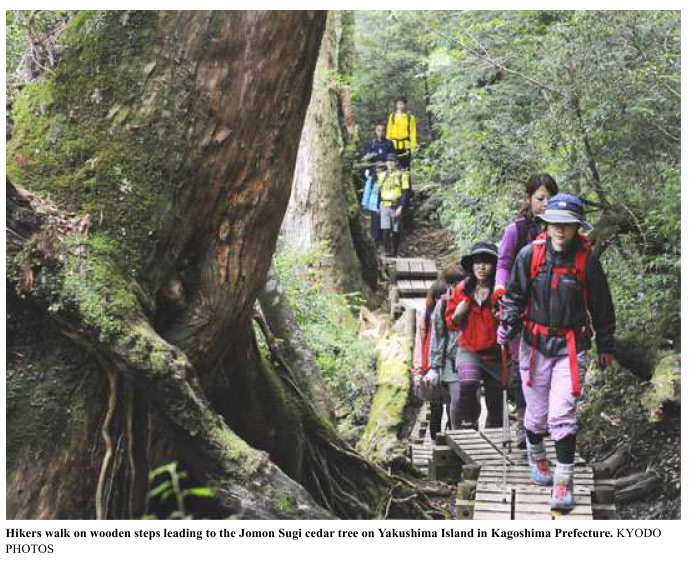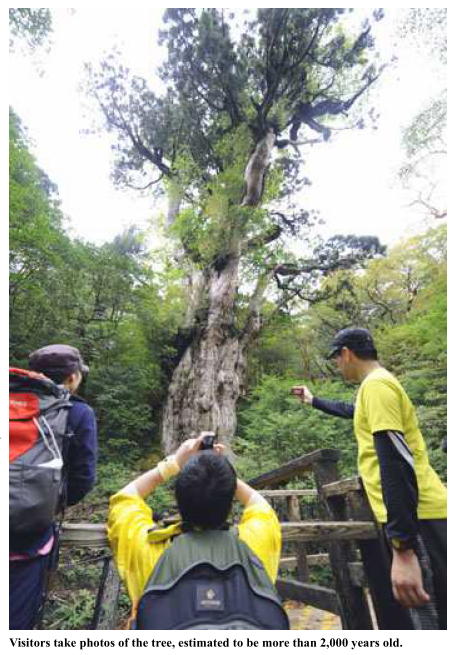Environment-Tourism balance on Yakushima
Yakushima seeks environment-tourism balance
YAKUSHIMA, Kagoshima Pref. — Yakushima Island off Kagoshima Prefecture in 1993 became the country’s first natural site to be entered on UNESCO’s World Heritage list, together with the Shirakami Mountain Range in northeastern Japan. Known for its many large cedar trees and hot springs, Yakushima is still enjoying a boom in tourism 18 years after registration.
The increase in the number of visitors,however, has caused the island’s environment to deteriorate, and the local town government has been exploring ways to make tourism compatible with environmental protection.
The number of visitors to the famous Jomon Sugi cedar tree on the island’s 1,396-meter Mount Miyanoura, the highest peak in the Kyushu region, reached about 90,000 in 2010, a threefold increase from 2000.
The number of daily visitors to the Jomon Sugi tops 500 for 40 days a year, mainly during the spring Golden Week and summer holiday seasons. The Jomon Sugi is the oldest and largest cedar tree on Yakushima Island, measuring 25.3 meters in height and about 16 meters in circumference at its widest.
Akio Manatsu, 56, who has guided tourists for more than 20 years on the island, said the area around the Jomon Sugi tree is crowded like a city street on days when about 1,000 people visit.
“Due to too many visitors,the wildwood atmosphere might have been destroyed,” Manatsu said.
Members of UNESCO’s World Heritage Committee visited the area in 1997 and pointed out that the roots of the cedar were more exposed than when the tree was designated as a World Heritage site.
Acting on the committee members’ warning, local authorities established wooden steps at several points along the route to the Jomon Sugi cedar tree and also set up a viewing deck at a point some 12 meters away to prevent visitors from stepping on the cedar’s roots. But visitors often trample the ground when they pass each other on the steps. A shortage of toilets has also become a serious problem for visitors.
Hidekazu Tsukada, who heads the town government’s environmental policy division,is against a proposed expansion of sidewalks for tourists, saying the value of Yakushima as a World Heritage site will decline if more man-made structures are built.
“The number of visitors will increase if the footpaths are widened,” he said.
The Yakushima municipal government is currently studying capping the number of daily visitors to the Jomon Sugi tree at 420.
In June 2010, the town government submitted to the municipal assembly a bill to require visitors to obtain advance permission to visit the Jomon Sugi area and pay a ¥400 charge. The bill was voted down, reflecting opposition from the local tourism industry worried about a decline in the number of tourists to the island. The then mayor of Yakushima intended to file a revised bill with the assembly but lost the mayoral election in October 2010.
Hiroshi Onodera, a professor of environmental science at state-run Kagoshima University, called for restarting discussions from the beginning to rethink the island’s future course. If the town government can diversify the concentration of visitors from specific seasons, it would be beneficial for the island’s economy, said Onodera, who previously worked at the Environment Ministry.
Source: The Japan Times: 01/01/12
Back to Home


